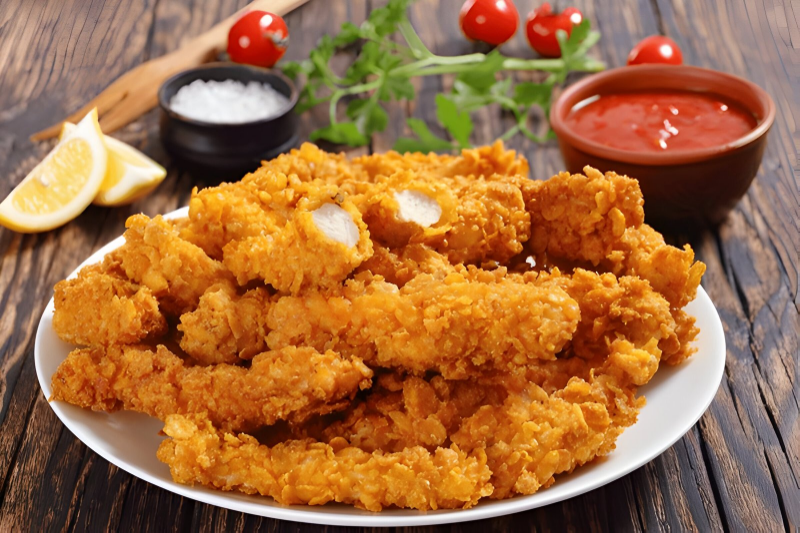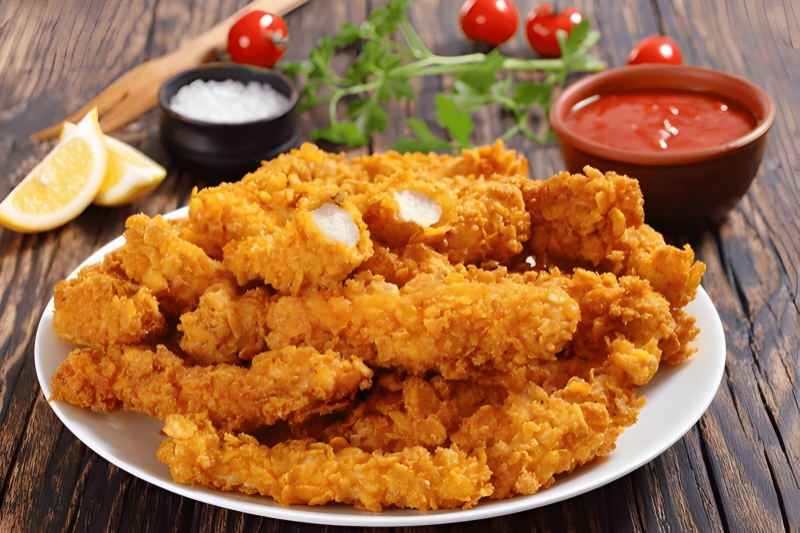Fried Chicken Recipe

Ingredients:
– 1 whole chicken, cut into 8 pieces
– 2 cups buttermilk
– 2 cups all-purpose flour
– 2 teaspoons salt
– 1 teaspoon black pepper
– 1 teaspoon paprika
– 1 teaspoon garlic powder
– 1 teaspoon onion powder
– 1 teaspoon dried thyme
– 1 teaspoon dried oregano
– Vegetable oil, for frying
Instructions:

1. Place the chicken pieces in a large bowl and pour the buttermilk over them. Make sure all the chicken pieces are well coated. Cover the bowl and refrigerate for at least 2 hours, up to overnight. This will help tenderize the chicken.
2. In a separate bowl, combine the flour, salt, black pepper, paprika, garlic powder, onion powder, dried thyme, and dried oregano. Mix well to evenly distribute the spices.
3. Heat vegetable oil in a deep frying pan or Dutch oven over medium heat. The oil should be about 2 inches deep.
4. Take each chicken piece out of the buttermilk, allowing any excess to drip off, and then dredge it in the flour mixture. Shake off any excess flour and place the coated chicken on a plate.
5. Once the oil is hot enough (around 350°F/175°C), carefully place a few chicken pieces in the pan, making sure they do not touch each other. Fry the chicken in batches to avoid overcrowding the pan.
6. Fry the chicken for about 15-20 minutes, turning occasionally, until it is golden brown and cooked through. Check the internal temperature with a meat thermometer, making sure it reaches 165°F (74°C).
7. Remove the fried chicken from the oil and transfer it to a plate lined with paper towels to drain excess oil.
8. Repeat the frying process with the remaining chicken pieces, maintaining the oil temperature and ensuring they are cooked thoroughly.
9. Serve the classic fried chicken hot with your favorite dipping sauce, coleslaw, mashed potatoes, or any side dishes you prefer.
A Tasty Journey Through Fried Chicken’s History
Fried chicken is a popular meal that has spread throughout many cultures, especially in the South of the United States. Comfort and nostalgia are evoked by its succulent, soft flesh and crispy, golden crust. But how did this well-known meal get started? Let’s investigate the intriguing past of fried chicken, from its earliest origins to its current level of appeal.

Historical Roots
The history of fried chicken dates back to prehistoric times. According to historians, frying chicken originated in the Roman Empire at the very least, when birds were fried in oil and seasoned with a variety of herbs and spices. But fried chicken grew increasingly popular in other regions of the world, especially in Asia and Africa.
For example, frying chicken was a prevalent practice in West Africa long before European settlers arrived. The cooking methods adopted by West African cooks, who generally used a combination of spices and deep-frying techniques, substantially affected the production of fried chicken. Africans who were taken to the Americas as slaves carried their culinary customs with them, which would eventually influence.
Influence from the South
A lot of what we know as fried chicken comes from Southern cookery. Through a fusion of English, Scottish, and African cooking techniques, fried chicken rose to popularity in the Southern United States by the 1800s. Cooks from Africa contributed their own spices and tastes, and Scottish immigrants brought the practice of frying chicken in oil.
Fried chicken, which is frequently served at family get-togethers, church picnics, and other celebrations, swiftly gained popularity as a symbol of Southern hospitality. It was a meal that embodied warmth and tradition and drew people together. Fry chicken became an art form in many Southern homes, with family secrets and methods passed down through the centuries.
The Significance of Sharecropping and Slavery
The intricate social fabric of the American South is entwined with the history of fried chicken. Africans who were held as slaves were frequently in charge of cooking for their masters, modifying their customary cooking techniques to make the most of the supplies at hand. As they gained cooking skills in the plantation kitchens, they infused elements of their cultural background into the food they made.
Many freed slaves turned to sharecropping after the Civil War, where they continued to hone their culinary abilities. African American communities began to enjoy fried chicken as a meal, praising its taste and cultural importance. Around this period, it also started to become known outside of the Southern states, partly because African American chefs founded eateries and displayed their skills.
The Growth of Fast Food
There were major developments in the preparation and consumption of fried chicken over the 20th century. The fast-food industry’s growth increased demand for fried chicken. Colonel Harland Sanders debuted his renowned blend of eleven herbs and spices when he established the first Kentucky Fried Chicken (KFC) business in 1930. Fried chicken underwent a sea change as a result, becoming more widely available and becoming an international sensation.
The Growth of Fast Food
There were major developments in the preparation and consumption of fried chicken over the 20th century. The fast-food industry’s growth increased demand for fried chicken. Colonel Harland Sanders debuted his renowned blend of eleven herbs and spices when he established the first Kentucky Fried Chicken (KFC) business in 1930. Fried chicken underwent a sea change as a result, becoming more widely available and becoming an international sensation.
Due to KFC’s popularity, several fried chicken franchises with distinctive menu items have since arisen. Fried chicken was popularized by the fast-food industry, from Popeyes to Church’s Chicken, and became a practical choice for working families.
Cultural Influence
Fried chicken is now a delicacy that is enjoyed not only in the US but also internationally. The meal has been altered and embraced by many civilizations, resulting in regional variants that showcase local ingredients and preferences. For instance, fried chicken is sometimes double-fried in Korea for added crunch and glazed with sweet or spicy sauces; in Japan, meanwhile, it’s referred to as karaage and is marinated and coated in potato starch before being cooked.
Another comfort food icon in popular culture is fried chicken. It frequently appears in works of literature, music, and film and is connected to happy occasions and get-togethers with family. Its ability to unite people is demonstrated by its attendance at gatherings such as potlucks, barbecues, and Sunday meals.
In summary
Fried chicken has a long and diverse history that reflects a confluence of social and cultural influences. Fried chicken has changed over time while retaining its fundamental characteristics of coziness and togetherness, from its ancient beginnings to its current position as a favorite throughout the world. Fried chicken continues to have a particular place in people’s hearts—and stomachs—around the world, whether it is consumed in a fast-food restaurant or at a backyard BBQ. Thus, the next time you enjoy a piece of crispy fried chicken, pause to recognize the rich culture and history that surround this well-loved food.
Enjoy your homemade classic fried chicken! and visit us

